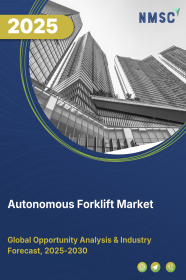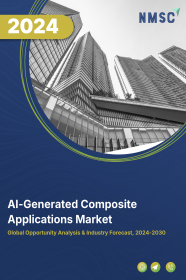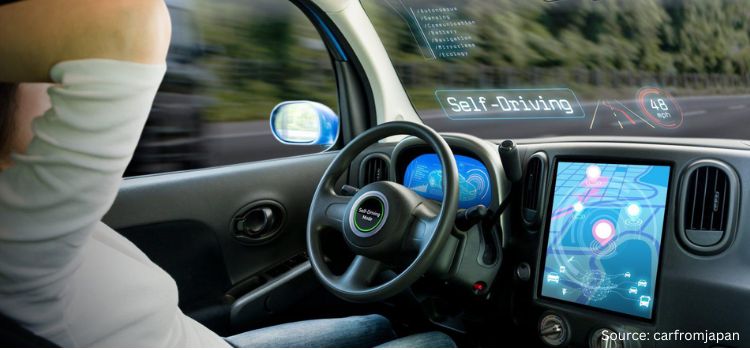
Autonomous Forklift Market by Type (Reach Trucks, Counterbalanced Forklifts and Others), by Tonnage Capacity (Below 2 Tons, 5 to 10 Tons, and Others), by Navigation Technology (Laser, Vision, Optical Tape and Others), by Power Source (Battery-Powered, and Others), by Application (Material Handling, Inventory Management, and Others), and by End Users (E-Commerce, Food & Beverage and Others) – Global Opportunity Analysis and Industry Forecast 2025-2030
US Tariff Impact on Autonomous Forklift Market
Trump Tariffs Are Reshaping Global Business
Autonomous Forklift Market Overview
The global Autonomous Forklift Market size was valued at USD 4.94 billion in 2024 and is predicted to reach USD 5.47 billion by the end of 2025. The industry is predicted to reach USD 9.10 billion by 2030 with a CAGR of 10.7% from 2025 to 2030.
The autonomous forklift market is gaining momentum as businesses seek reliable solutions to address labor shortages, enhance workplace safety, and streamline logistics. Key trends such as the rise of e-commerce, evolving safety standards, and the integration of artificial intelligence (AI) are shaping market dynamics. Industry players are responding with innovative models designed to reduce manual dependency and improve operational efficiency. While the high upfront cost remains a hurdle, particularly for small and medium-sized enterprises, the long-term benefits and alignment with digital transformation goals present strong incentives for adoption across smart warehousing and intralogistics environments.
Labor Shortages Across Warehouses Drives the Market Growth
The global shortage of skilled warehouse labor is a major driving factor for the autonomous forklift market. With rising e-commerce and tight delivery schedules, companies are struggling to fill warehouse roles. Autonomous forklifts, such as those developed by Fox Robotics and Cyngn, offer an effective solution by automating repetitive and labor-intensive material handling tasks. According to Reuters, Walmart is planning a $200 million investment in autonomous forklifts to streamline operations, illustrating the growing corporate push toward workforce automation.
Rising Safety Standards Accelerates the Autonomous Forklift Market Growth
Worker safety has become a top priority for industries, especially in high-traffic warehouse environments. Autonomous forklifts equipped with collision detection systems and advanced sensor arrays are helping reduce accidents significantly. For example, VisionNav and BlueBotics have launched AI-powered forklifts capable of navigating tight aisles and detecting human presence, minimizing risks. These safety-enhancing features are not just regulatory compliant but also critical in gaining stakeholder trust, reinforcing the case for broader adoption.
Surge in E-commerce Sector Drives Growth in Autonomous Forklift Market
The exponential growth of e-commerce is placing immense pressure on supply chains to deliver faster and more efficiently. Autonomous forklifts are key to this evolution, enabling real-time inventory handling and reduced processing time. Companies such as Amazon and Holman Logistics are already using autonomous forklifts to meet the high operational demands of omnichannel fulfillment. As real-time responsiveness becomes essential, autonomous systems are emerging as vital tools in optimizing throughput and minimizing human error.
High Capital Investment Limits Widespread Adoption of the Autonomous Forklift Market
Autonomous forklifts offer long-term efficiency and operational benefits, but the high initial investment continues to be a key barrier, especially for small and medium-sized enterprises (SMEs). These systems come equipped with advanced navigation, sensors, and IoT features, which significantly raise the hardware and software costs. Additionally, integrating them with existing warehouse management systems (WMS) or retrofitting older forklift fleets adds to the financial burden. Without clear short-term returns, many businesses remain cautious about committing to these technologies.
Integration of Artificial Intelligence Presents Lucrative Opportunity for Market Growth
The integration of artificial intelligence (AI) in autonomous forklift help to analyse real-time data, adapt to changing environments, and optimize routes for material handling. This technological advancement in automated forklift is expected to create ample opportunities for market growth in the forthcoming years.
For instance, in 2024, the launch of Fox Robotics' MK3 Autonomous Forklift, designed for dock operations with advanced AI navigation and obstacle detection. This next-generation model supports automated trailer unloading, significantly lowering manual labor dependency. As AI capabilities continue to evolve, manufacturers are expected to roll out more intelligent, predictive, and self-learning forklift models. These innovations are creating ample opportunities for players aiming to expand their market share and improve ROI across smart warehousing and intralogistics ecosystems. The ability to process real-time data, adapt to dynamic environments, and optimize routing not only enhances operational efficiency but also aligns with broader trends in digital transformation and Industry 4.0 adoption.
Market Segmentation and Scope of the Study
The autonomous forklift market report is segmented by type, tonnage capacity, navigation technology, power source, application, end users, and regions. In terms of type, the market is divided into reach trucks, counterbalanced forklifts, pallet jacks, order pickers, and others. Regarding tonnage capacity, it is segmented into below 2 tons, 5 to 10 tons, and above 10 tons. The market is also segmented by navigation technology into laser, vision, optical tape, magnetic, and inductive guidance.
Power source segmentation is classified into battery-powered, electric-powered, and hybrid. On the basis of applications, the market is divided into material handling, inventory management, order fulfillment and picking, manufacturing and production lines, loading and unloading, and others. Finally, by end users, the market includes e-commerce, food & beverage, pharmaceutical, chemical, automotive, and others. Regional analysis covers North America, Europe, Asia-Pacific, and RoW (Rest of the World).
Geographical Analysis
North America continues to lead in the adoption of autonomous forklifts, supported by a mature logistics infrastructure and rapid integration of AI and IoT technologies across industries. Companies like Fox Robotics and Third Wave Automation are driving innovation, particularly in warehouse automation and e-commerce logistics. The region's significant market share stems from early adoption by retail giants such as Amazon and Walmart, both actively deploying automated forklifts to enhance efficiency and reduce labor reliance, with Walmart planning a $200 million investment in self-driving forklifts, as noted in posts on X. The market size in this region is further bolstered by substantial investments in supply chain automation and federal initiatives encouraging smart manufacturing, such as the U.S. Department of Commerce’s National Institute of Standards and Technology (NIST) Advanced Manufacturing Technology Consortia (AMTech) program, which allocated USD 26 million in 2024 for AI-driven manufacturing solutions. Ongoing labor shortages, with the U.S. Bureau of Labor Statistics reporting a 3.2% decline in warehouse labor availability from 2022 to 2024, and a strong push for workplace safety, evidenced by the Occupational Safety and Health Administration (OSHA) (osha.gov) recording a 15% reduction in forklift-related injuries in automated facilities, also contribute to the growth potential of this sector.
Europe represents a key hub for autonomous forklift development, with a strong focus on sustainability, regulatory compliance, and safety standards. Countries like Germany, France, and the Netherlands are seeing rising deployment of AGVs (Automated Guided Vehicles) and AI-enabled forklifts in industries ranging from automotive to pharmaceuticals. Key players such as KION Group are investing in simulation-based models and predictive analytics to improve warehouse operations. The European industry size is supported by policy-driven digitization under frameworks such as Industry 4.0 and Horizon Europe. However, the fragmented regulatory environment and higher costs of deployment pose moderate challenges to market expansion across smaller enterprises.
Asia-Pacific is emerging as the fastest-growing region in the autonomous forklift industry, propelled by rapid industrialization, e-commerce growth, and government-backed automation programs. China, Japan, and South Korea are at the forefront, with firms like VisionNav Robotics and Aiten Robotics introducing AI-powered solutions tailored for high-density warehouses and smart factories. The region’s robust market trends are shaped by rising labor costs, with China’s National Bureau of Statistics reporting a 7% annual increase in manufacturing wages from 2020 to 2024, high demand for intralogistics solutions, and a growing manufacturing base. Strategic partnerships and smart city initiatives, such as Japan’s Ministry of Economy, Trade and Industry (METI) investing USD 30 billion in 2024 for Society 5.0 smart logistics projects, are also fostering long-term growth potential, positioning the region as a crucial player in global market size dynamics.
The Rest of the World, including Latin America, the Middle East, and Africa, shows emerging interest in autonomous forklift solutions, but lags behind due to infrastructural limitations and budgetary constraints. That said, select markets such as the UAE and Brazil are witnessing early deployment in large-scale warehouses and ports. Global OEMs and tech firms are increasingly exploring partnerships and pilot programs to penetrate these untapped segments. While current market share remains limited, improvements in connectivity, logistics modernization, and foreign direct investment (FDI) inflows, with Brazil’s Central Bank reporting a 12% increase in FDI in logistics infrastructure that is around USD 2.8 billion in 2024, and the UAE’s Ministry of Economy noting USD 500 million in smart port investments, may gradually accelerate the industry size in these regions over the next decade.
Strategic Moves in Autonomous Forklift Innovation
Leading players in the global autonomous forklift industry are focusing on strategic innovations that combine artificial intelligence, robotics, and machine vision to enhance operational efficiency and address evolving logistics challenges. For instance, Fox Robotics introduced its MK3 Autonomous Forklift in 2024, tailored for automated trailer unloading in high-volume dock operations. This solution showcases the trend toward integrating real-time navigation and obstacle detection capabilities to reduce manual labor and improve workflow reliability. Similarly, Cyngn is partnering with OEMs to embed AI and telematics features into their autonomous systems, creating smarter forklifts suited for dynamic industrial environments.
However, companies face persistent challenges such as high upfront costs, complex retrofitting processes, and limited standardization across deployment sites. These hurdles are particularly prominent for small and mid-sized businesses seeking scalable automation. On the upside, rapid advancements in edge AI, warehouse digitization, and labor shortages are opening new doors for growth. As regulatory frameworks mature and sensor technologies evolve, firms that prioritize safety, system interoperability, and user-friendly design are likely to shape the future of autonomous material handling.
Key Benefits
-
The report provides quantitative analysis and estimations of the autonomous forklift market from 2025 to 2030, which assists in identifying the prevailing market opportunities.
-
The study comprises a deep dive analysis of the autonomous forklift market including the current and future trends to depict prevalent investment pockets in the market.
-
Information related to key drivers, restraints, and opportunities and their impact on the autonomous forklift market is provided in the report.
-
Competitive analysis of the players, along with their market share is provided in the report.
-
SWOT analysis and Porters Five Forces model is elaborated in the study.
-
Value chain analysis in the market study provides a clear picture of roles of stakeholders.
Autonomous Forklift Market Key Segments
By Type
-
Reach Trucks
-
Counterbalanced Forklifts
-
Pallet Jacks
-
Order Pickers
-
Others
By Tonnage Capacity
-
Below 2 Tons
-
5 to 10 Tons
-
Above 10 Tons
By Navigation Technology
-
Laser
-
Vision
-
Optical Tape
-
Magnetic
-
Inductive Guidance
By Power Source
-
Battery-Powered
-
Electric-Powered
-
Hybrid
By Application
-
Material Handling
-
Inventory Management
-
Order Fulfilment and Picking
-
Manufacturing and Production Lines
-
Loading and Unloading
-
Others
By End Users
-
E-Commerce
-
Food & Beverage
-
Pharmaceutical
-
Chemical
-
Automotive
-
Others
By Region
-
North America
-
The U.S.
-
Canada
-
Mexico
-
-
Europe
-
The UK
-
Germany
-
France
-
Italy
-
Spain
-
Denmark
-
Netherlands
-
Finland
-
Sweden
-
Norway
-
Russia
-
Rest of Europe
-
-
Asia Pacific
-
China
-
Japan
-
India
-
South Korea
-
Australia
-
Indonesia
-
Singapore
-
Taiwan
-
Thailand
-
Rest of Asia Pacific
-
-
RoW
-
Latin America
-
Middle East
-
Africa
-
Key Players
-
Toyota Industries Corporation
-
Hyundai Construction Equipment Co. Ltd.
-
Cyngn
-
ArcBest Corporation
-
Oceaneering International Inc.
-
Mitsubishi Heavy Industries Ltd.
-
Kion Group
-
Otto Motors
-
Manitou Group
-
Vecna Robotics
-
Gridbots Technologies Private Limited
-
FOX Robotics
-
VisionNav Robotics Inc.
-
Crown Equipment Corporation
-
4am Robotics GmbH
REPORT SCOPE AND SEGMENTATION:
|
Parameters |
Details |
|
Market Size in 2024 |
USD 4.94 billion |
|
Revenue Forecast in 2030 |
USD 9.10 billion |
|
Growth Rate |
CAGR of 10.7% from 2025 to 2030 |
|
Analysis Period |
2024–2030 |
|
Base Year Considered |
2024 |
|
Forecast Period |
2025–2030 |
|
Market Size Estimation |
Billion (USD) |
|
Growth Factors |
|
|
Countries Covered |
28 |
|
Companies Profiled |
15 |
|
Market Share |
Available for 10 companies |
|
Customization Scope |
Free customization (equivalent up to 80 working hours of analysts) after purchase. Addition or alteration to country, regional, and segment scope. |
|
Pricing and Purchase Options |
Avail customized purchase options to meet your exact research needs. |

















 Speak to Our Analyst
Speak to Our Analyst



















